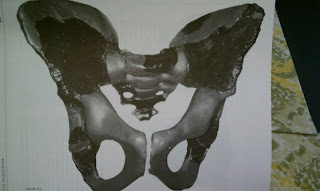Weidenreich Reconstructions ("Late Asian erectus")
Classic composite Wiendenreich reconstruction

Lateral view of the classic composite Wiendenreich reconstruction
Mandible from the classic composite
Skull from Broken Hill
Note. The strong presence of a supra-orbital torus and the angled zygomatics
Comparison of a modern human femur and the femoral head and knee from Broken Hill. Note that the two are almost indistinguishable
If H. heidelbergensis is a valid species, the following are considered members:
From Sima de los Huesos, Spain: Skull 5
Mandible of Skull 5
From Saldanha, South Africa
Mauer Mandible (German)
Comparison of mandibles:
From above left to bottom right: two modern human mandibles, the Mauer mandibles, and the Skull 5 mandible
H. erectus sensu stricto
Sangiran VI:
Bottom view of the foramen magnum (left) , as well as the posterior portion of the skull (right)
Sangiran VI: Meganthropus

Teeth and portion of the mandible
Teeth and portion of the mandible
Sangiran 17










































